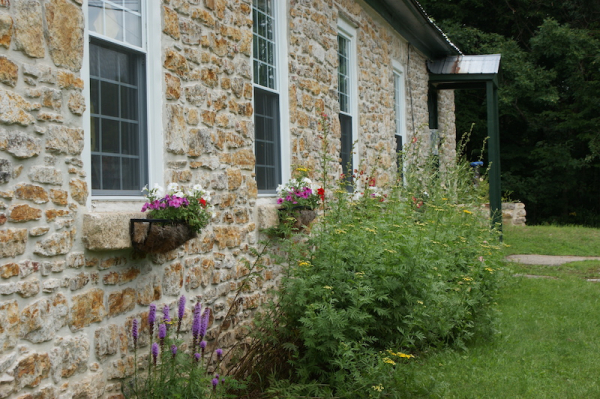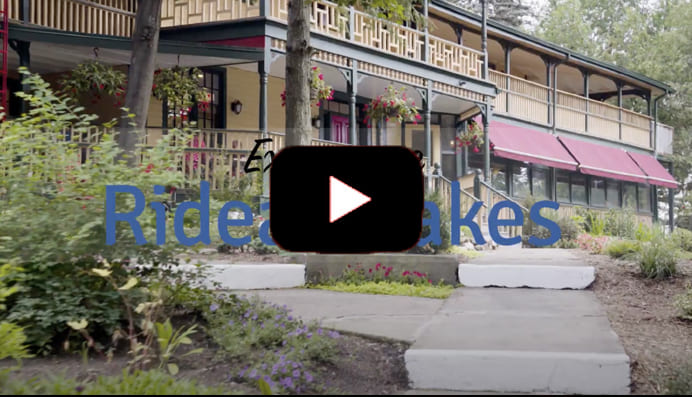A Brief History
For millennia, hunters and fishers traversed the height-of-land between the Rideau and Mud (Newboro) Lakes. European explorers, missionaries, traders and pioneers followed. But without falling water for power, rumor and record has it that by the year 1820 only a few settlers had cleared forest and cropped land on this “band of bush” that divided the Rideau from the Cataraqui Basin. But that all changed. During the years 1826-32, the Rideau Canal was built under the direction of Lieutenant Colonel John By and the Royal Engineers as part of British defense strategy in North America. This canal linked the navigable waters of the Rideau River System flowing northward to Bytown (now Ottawa) and the Cataraqui System flowing southward toward Kingston. Excavating this connective channel at the isthmus was one of the most difficult tasks undertaken. It demanded digging and blasting through a hard ridge of Canadian Shield granite lurking in the landscape. Many lives were lost to accidents and swamp fever (malaria). Private contractors went bankrupt. Ultimately the 7th Company of Royal Sappers and Miners completed this vital link between 1829 and 1832.
In time, the construction community called “The Isthmus” faded away and a new community located on the east side of the channel took form. This place of people and commerce was formally named New Borough, then Newboro.
Throughout the 19th century, Newboro grew and prospered at the keystone of the Rideau arch. Built to defend British North America from American invasion, the Rideau Canal transported vast amounts of produce from forest and farm to the United States, especially to the North during the Civil War. In the latter part of the 19th century, steam tugs towed barge loads of iron ore from local mines to smelters south of the border. Cotton bag miners bartered their books of mica to General Electric.
Newboro developed as a thriving community. The bridge spanning the Rideau Canal became a busy link in the “Stone Road” to Westport. “Main Street” still hints of an era of travel and commerce, lodgings and shops, a bustling streetscape that paralleled the Canal. Warehouses and wharves, some owned by the renowned Tett family skirted the canal. A blast of the steam boat whistle announced the arrival of the Rideau King or Rideau Queen; travelers from far-off Smiths Falls and beyond; voyagers to far-off Kingston and beyond. You can still find a cleat anchored in stone along the canal where barges tied up to load and unload their cargoes.
In 1888, the Brockville - Westport & Sault Ste. Marie Railway added a new dimension of travel, even in winter. Produce of local farm, forest and fur trapping entered wider markets through Newboro’s cannery, mills and merchants. From Newboro Station, local scholars went to and from high school in Athens and Brockville.
Straddling the “town line” boundary between North and South Crosby and feeling economically and politically distinct from both Crosbys, Newboro declared its independence in 1876 and for many decades it bragged of being an “incorporated village”; one of the smallest incorporated communities in Ontario. Now, Newboro is a vital part of North Crosby Ward of our Township of Rideau Lakes.
Surrounded by lakes including the Upper Rideau and Newboro Lake, Newboro has become a popular vacation center. Annually people come to enjoy our scenery and the diverse array of activities the lake offers. The ambiance of our fine historic inns continue to attract people from afar. Welcome aboard.
Walking Tour
-
St. Mary’s Anglican Church, 1861
15 Brock Street

Anglicans first held their meetings in an “upper room” of Benjamin Tett’s home (built 1835). There at No.1 Main Street a saddlebag preacher, Rev. T. Tremayn, proclaimed the Will of God from 1839 to 1857. In due time, the devout congregation of St. Mary’s built their permanent house of worship. Benjamin J. Tett purchased the land and paid the wages of the workmen who built this church. When the last shingle was to be nailed to the roof, the carpenter called for John Poole Tett, Benjamin’s son, to swing the hammer. Thus, two generations of the Tett family worked on their church.
Built in simple Gothic Revival style, this church has high walls and a belfry with a short spire on a square tower. Beautiful stained glass adorns its windows; one of exquisite Tiffany. Inside, there is an elegant altar with a communion rail enclosing two sides. At the left front is a “rostrum pulpit” and on the right front are the organ and choir stalls. There is still evidence of the “Boxed Pews”. Exquisite woodwork attests to the dedicated craftsmanship of the builders and the devoted care of its loyal congregation over the past fifteen decades.
-
Court House, c 1840
10 Brock Street

Built in 1840, Newboro’s Court House retains its original exterior design. There was one addition, evidence of which can be seen along the west face. Once used as Town Hall, Court House and jail, the door to the cell was recently located and has been re-hung in the back room of the building. Interestingly Newboro employed an executioner for years, although it is unclear if his services were ever required.
Paddy O’Rourke was one of the first persons to be tried in Newborough’s new Court House. In November of 1842, Paddy was angry with the magistrate for fining him “seven & sixpence” for being intoxicated while trying to board a steamboat without fare. During the night, he stole what he thought was a keg of blasting powder from Tett’s warehouse and concealed it behind the courthouse. The next afternoon, Court was in session with the same despised magistrate presiding. Paddy, keg under arm and ambitions of Guy Fawkes in mind, looked around the courthouse for a basement door. Finding none (for there was no basement), he planned to set the keg against the end of the building, light the fuse and run. When he knocked the bung from the keg, he found its contents not to be blasting powder but rum. This was too good to pass up; so sitting beside it, Paddy commenced to drink the rum, the fuse still sticking out of the barrel. Needless to say, he was eventually found passed out, arrested, and tried for theft. For many years afterwards, the youth of Newboro made dummies to represent old Paddy. Each November 10th, they would wheel it through the streets shouting, “A penny for old Paddy please”. A popular rhyme of the day was:
“Please do recall,
The boozy downfall
Of Paddy O’ Rourke’s crazy plot.
We will remember
The 10th of November.
In Newboro, it won’t be forgot!”
Newboro Newsletter; Nov.13, 1911
Once used as a public school, separate entrances for boys and girls can still be seen on the front façade. One might surmise that some students found little distinction between the building’s role as a school and as a jail. This place of rhyme and reason is now our Library.
-
Richard Blake House, c 1858
14 Main Street

The Blake House is just one of several fine examples of “Ontario Cottages” in Newboro. The Ontario Cottage is typical of many homes of the mid-1800’s; one- and-one-half stories in height and built by frugal owners. Tax laws from between 1807 and 1853 assessed houses as either one full storey or two full stories. A gable window over the front doorway provided light to a central hallway on the upper floor. Window designs could be pointed Gothic, square-headed Tudor, round-headed, (usually shuttered), circular or large three sectional. The decorative bargeboard, often called gingerbread was usually added in the mid 1850’s when more delicate woodworking tools became available to local tradesmen. The verandah became an important feature of Ontario Cottages, generally being added in the latter half of the 19th century.
-
“Dominion House” Hotel, c 1865
15 Main Street

Thomas Kenny and his son, James, constructed this fine building along Main Street on property purchased from Benjamin Tett. Originally an inn on this busy thoroughfare, it is said that Sir John A. MacDonald stayed here overnight. George Bolton bought the building for his private residence in 1887 and it remained in the family until the 1990s. Harken to the echo of horse and harness enroute to where Main Street once turned and bridged the Rideau Canal. Imagine the whistle of the B. & W. arriving on the nearby railway track. Imagine the smell of wood-fired steamers on the Canal and the aroma of apples being processed in the cannery at the end of Main Street.
A century-and-a-half after construction, the “Dominion House” still contains an interesting and authentic example of a semi-elliptical or fan-tailed neo-classic (Loyalist) door. Such portals were popular in houses built during the latter half of the 19th century. But this Adamesque entrance is unique. Over one hundred similar designs have been recorded in the area but only four such doorways are identical.
-
R.O. Leggett House & Shop, c 1870
4 Main Street

Mr. R.O. Leggett, following his father Henry, owned a furniture and undertaking business here. This L-shaped structure is typical of late nineteenth century commercial-residential structures. Note the intricate treillage work on the veranda posts. As in most local villages during the 1800s, the trades of furniture making and funerary were closely allied; the materials, tools and skills for making fine tables and chairs were the same as the fashioning of fine coffins! Mr. Leggett also owned a livery from whence he provided the horse power to transport travelers from village to village and dearly departed from church to graveyard; a one-way trip, not to be rehearsed. For almost nine decades, the Leggett family served the Newboro community from this fine home and business on Main Street.
-
John Webster House, c 1860s
5 Main Street

William Bell had a house here that was destroyed by fire before 1860. Indeed, Newboro has lost many heritage structures to the ravages of flames. John Webster bought lots 3 and 4 and it is believed he built this elegant home and provided lodging to travelers. Built sometime around 1860, this frame house contains excellent examples of Classical Revival architecture. The entrance manifests a rectangular transom with sidelights, typical of Revival architecture. These doorways were useful as well as decorative for they let natural light into the central hallway during times before Edison’s light bulb. The bracketed shelf above the door was probably a later addition, as were the Doric columns flanking the sidelights. The central window is of unusual interest. Of casement variety with a fanlight transom above it, its style is completely unconformable with the rest of the house. In 1903 George Wrathall purchased the home and operated a jewelry business from it.
-
Col. John Kilborn Home
2 Drummond Street

This building of mixed styles is believed to be a combination of John Kilborn’s home and George W. Preston’s “Ottawa Hotel” which burned in 1903. The stone component of this building is believed to be material recovered from the Ottawa Hotel.
There is a simple frieze that runs under the overhanging eaves. The frame structure was Col. Kilborn’s home. In 1828 while living in Brockville, Col. Kilborn was elected to Parliament. When his term expired, he declined re- election and moved to Kilmarnock. In 1852, he was appointed postmaster of Brockville, from which he later resigned and ran unsuccessfully for Parliament against Mr. Benjamin Tett. He then retired to Newboro. Colonel Kilborn donated the site for the first Wesleyan Presbyterian Church on Drummond Street in 1850, and he and the five Chamberlain brothers had the church erected. Col. Kilborn and his wife Elizabeth Sherwood had nine children – eight sons and one daughter. This eminent citizen of Newboro died in his 94th year.
-
The Stagecoach Inn, c 1855
4 Drummond Street

James MacDonald, an early merchant in Newboro built this substantial home and business. In 1872, William O’Connor purchased the building and converted it to “The Ontario Hotel”. The Landons then became the owners, changing its name to “Landon House”(1920-1966). In 1966, it became “The Stagecoach Inn”.
Its original design is Georgian. Although the front door has been replaced, it is reminiscent of the original entrance. The transom and sidelights are original and most attractive. In the dining room of The Stagecoach is a large painting of “The Ontario Hotel”(1869-1920) as it once graced Newboro, and still does.
-
Block House, c 1832

The blockhouse was built in 1832-33 to defend this very strategic lock station. Located on this height-of-land and cleared of surrounding forest, it was designed to withstand attack by Americans from any direction. The lower section, approx. 6m x 6m consists of stone walls 1m thick. The top section is constructed of squared timbers (now clapboarded), dovetailed at the corners and with an overhang of 0.6m.
This blockhouse is one of only four that were ever completed. Legend has it that only once was its militia called out for action, not to fend off a raid by feared foreign raiders, but to quell a local riot at Bully’s Acre at the end of Main St.
Newboro Lock is one of 3 on the Rideau that was modernized with hydraulically-operated steel gates. Community action demanded the preservation of historic aspects of the Rideau Canal, and the other 40 locks of our UNESCO World Heritage Site continue in the original mechanical mode of 1832.
-
John Poole Tett House, c 1896
14 By Street

Here, Robert Leech’s furniture factory once hummed with activity. Robert was one of 10 Leech sons who later founded the town of Gorrie, Ontario. Later, James Leggett’s tannery was located here. By the late 1800s, change was coming to Newboro, from primary industry to business and to tourism. Reputedly completed in 1886, this majestic residence reflects styles of homes built in the early 1900s. In contrast, it has brick trim characteristic of an earlier period. Note its tall windows, bays, and striking chimneys. From its uniquely styled front dormer on the 3rd storey, John Poole Tett and his wife Effie (nee Gallagher) enjoyed the view across a waterway of commerce and a land of resources. “The Manor” guests of Stirling Lodge now enjoy a more relaxed view of water, forest, and nature reincarnate.
-
John Draffin House, c 1854
11 New Street

Walk around the bend of New Street where it joins Ledge Street and you will find the first stone home constructed in the village. At the rear of this residence is an original single storey stone house. Built with ashlars of massive sandstone, it later served as a back kitchen. A fire in 1895 demanded extensive renovations and a second floor was added.
Born in Ireland in 1811, John Draffin emigrated to the Canadas. Prospering as a merchant, he added this magnificent residence to the original farmhouse c1860. Elaborate detail of Italianate style on the main house includes wide, bracketed cornices and on the corners are larger ashlars of a pattern termed quoining. Decorative round-headed doors grace the upper storey. Once these opened onto a small balcony above a grand front porch. From this balcony, Mr. Draffin, wealthy citizen of Newboro and his wife, Margaret Bell of Perth, could enjoy a magnificent view over Newboro Lake at a time when intervening trees had been cleared. Between 1895 and 1945 this was the parsonage for St. Mary’s Church. (#1)
-
J.T. Gallagher House, c 1885
7 Drummond Street

The Gallagher house was constructed with detail of Gothic Revival style. It is an extraordinarily tall building, being some two-and-one-half stories. The 1st storey was constructed of 5 courses of brick; the 2nd, four courses; and the 3rd of three, with inner walls of lath and plaster. To offset this dramatic perception of height, a two-storey bay extends from the front wing. Extensive dripped bargeboard (a popular addition to Gothic Revival buildings) serves to lower the roofline. Locally quarried sandstone lintels break the vast brickwork. With stylized treillage, the verandah conceals the double door entrance. Also of interest is the distinctive ornate roofing of slate, a feature unique in the village. Local legend tells of a contest between J.T.Gallagher and John Poole Tett, who was building his home on By Street (# 10) at the same time. These two prominent citizens with family connections vied to see who could build the tallest house. Gallagher won when he extended the height of his chimneys by some 0.4m. His son-in-law, Dr. Robert B. King purchased the home in 1916 and lived here until his death in 1942.
-
Union Bank Building, 1905
24 Drummond Street

Like many structures in the area, this was built of local brick. Constructed in 1905 by John F. Graham to house the Union Bank, the building remained in the Graham family for over a century. This two-storey building provided banking hall and offices on the first floor. The interesting cornicing and the flat roof are characteristic of several contemporary banks erected in the area. Its massive front façade with large arched windows and door imposes a sense of assurance and security on those entering with surplus shekels to save or loans to seek. The living quarters of the manager and his family were on the second floor where he could stay “on top of the money”. By the early 1900s, Drummond Street had become the focus of commerce, road traffic and parallel to rail travel. For over a century this fine example of rural “bank architecture” served Newboro commerce and community.






















